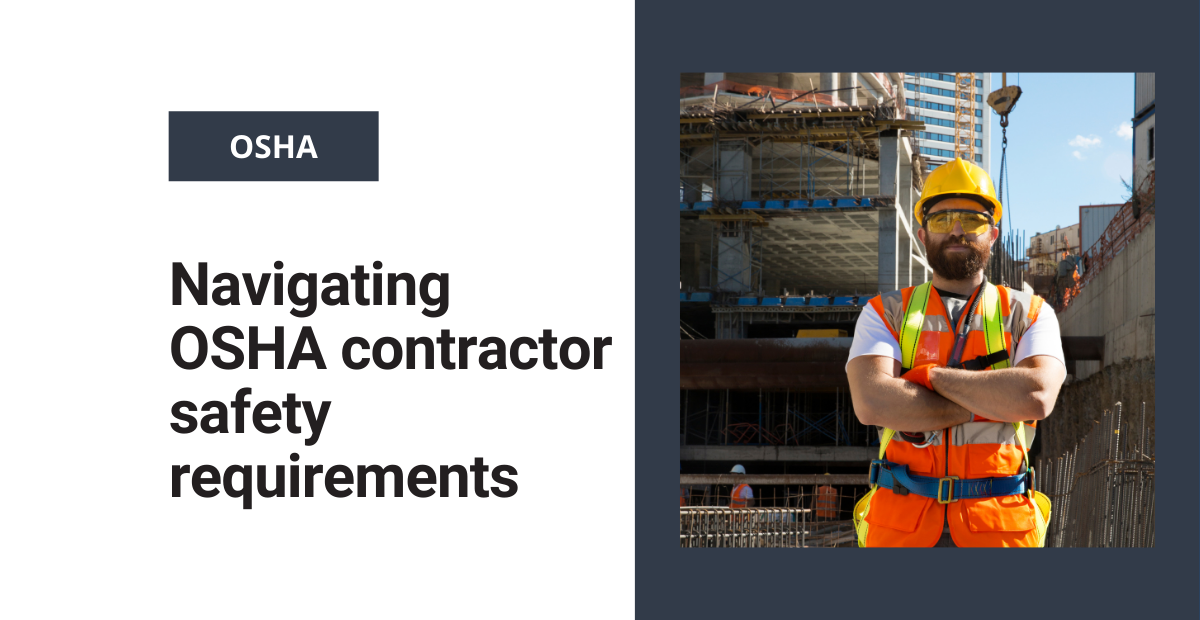It can be difficult to ensure contractor compliance with OSHA contractor safety requirements, especially if you’re not sure what OSHA’s requirements are for your industry. The bottom line is that you want to make sure all employees under your care are safe. To do this, you need top-notch safety training, a comprehensive safety plan, and a reliable way to track contractor compliance.
Free checklist!
Double check that you’ve collected all the necessary documents before allowing contractors onsite.
Safety guidelines for contractors
OSHA safety requirements specifically for contractors are relatively difficult to define. That’s because OSHA ultimately holds general contractors responsible for safety violations. Sometimes, contractors make agreements giving a subcontractor control over a specific part of their contract. If that’s the case, the subcontractor is liable for any safety incidents related to the section that they oversee.
OSHA standard 1926.16 contains more details about these scenarios. While this standard is specifically for the construction industry, its fundamental principles are useful for other industries as well.
OSHA holds businesses accountable via citations, but businesses should have enough incentive to comply with these guidelines on their own. After all, the very point of OSHA standards is to protect workers from negligent business practices. Treating contractors the same as employees (when it comes to safety incident prevention) should be a common practice regardless of industry.
Common citations to avoid
Without specific guidelines to follow, it helps to look at high-risk topics. These are areas that you should target when creating training materials and safety plans:
- Fall protection: Anyone working at your facility or jobsite should have the necessary fall hazard gear and training before starting work.
- Hazardous energy: Ensure that you have a solid MOC process and other procedures like lockout/tagout in place to prevent these types of incidents.
- Machinery and equipment: Workers should only have access to equipment if they have the proper credentials to operate it. This includes powered industrial trucks (PIT), electrical cables, process machines, and more.
These topics are some of the most-cited OSHA violations. To avoid the expense of a citation and the poor brand reputation that comes along with it, you should concentrate on mitigating these risks. Make sure to address them when developing contractor safety guidelines.
Contractor training and onboarding software
Frontline CSM allows you to assign and track training modules to all your contract employees.
Fulfilling contractor safety requirements
Because OSHA requirements are difficult to synthesize, you have some flexibility in your approach to contractor safety. The best method is to provide the same safety training and resources to contractors as you provide to your employees.
You can mitigate safety risks and eliminate hazards by:
- Administering high-quality safety training to all employees and subcontractors
- Using EHS software to identify patterns in workplace safety
- Documenting safety initiatives designed to get rid of hazards
- Performing detailed hazard analyses on a consistent and frequent basis
- Tracking leading and lagging indicators of safety performance
Having a detailed contractor safety plan is crucial before starting a project. This document contains important information regarding the contractor’s approach to safety. It includes details like:
- Emergency response protocols
- Project stakeholders
- Incident management approach
- Safety training requirements
A safety plan is important because it establishes a compliance system before work even begins. If the plan is tailored specifically to the project, it should guide managers and workers through any incidents or issues that arise. Adhering to a preestablished safety plan may protect contractors from OSHA citations. This is because it establishes a dedication to safe work practices.
But a detailed safety plan is just a document. What really matters is that contract employees follow prescribed safety procedures. Some companies find it difficult to oversee worksites across various locations. And without proper insight, all types of employees are vulnerable to safety hazards at the jobsite.
OSHA contractor oversight safety requirements
One of the hardest things about ensuring contractor compliance is tracking multiple teams. It’s even harder if you operate multiple facilities or jobsites. A good solution to this problem is EHS contractor management software. This type of software tracks whether contract workers have completed mandatory safety training. And workers can complete their modules remotely, making it easier to administer training for several sites.
If you only manage one worksite, you may not need a software solution right away. But it’s important to create a scalable system. While OSHA contractor safety requirements may not be clear-cut, you’re liable for ensuring the safety of anyone who works for you. Implement some of the approaches and tools outlined here to better protect both your workers and your business in the long-run.




